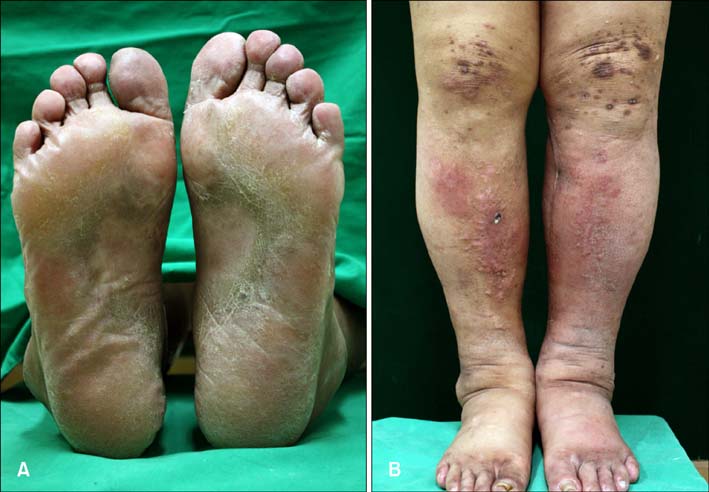Ann Dermatol.
2013 Nov;25(4):475-478. 10.5021/ad.2013.25.4.475.
Kaposi Sarcoma in a Patient with Chronic Renal Failure Undergoing Dialysis
- Affiliations
-
- 1Department of Dermatology, Inje University Busan Paik Hospital, Inje University College of Medicine, Busan, Korea. btyouth@hanmail.net
- 2Department of Pathology, Inje University Busan Paik Hospital, Inje University College of Medicine, Busan, Korea.
- 3Department of Dermatology, Inje University Haeundae Paik Hospital, Inje University College of Medicine, Busan, Korea.
- KMID: 2265061
- DOI: http://doi.org/10.5021/ad.2013.25.4.475
Abstract
- Kaposi sarcoma (KS) is a multicentric proliferative vascular tumor involving the skin and other organs. Human herpesvirus 8 (HHV-8) has been detected in KS lesions and is considered the putative causative agent of KS. The relationship between chronic renal failure, HHV-8, and KS is not clear. KS appears to develop in association with renal transplantation, but is unlikely with dialysis, and there have been few reports on this. Here, we report the case of a 51-year-old man, who underwent peritoneal dialysis to treat chronic renal failure, and presented with multiple brownish plaques on his soles. On histopathological examination, abnormally proliferated vessels, vascular slits, and spindle-shaped cells were seen in the dermis. Immunohistochemical staining for HHV-8 was positive. This case is another example in which factors other than immunosuppression contributed to the development of KS, due to activation of HHV-8.
MeSH Terms
Figure
Reference
-
1. Kim CH, Kim DH, Jeon JS, Kang SG, Kim DW, Cho MK. A case of zosteriform Kaposi's sarcoma after prednisolon treatment. Korean J Dermatol. 2009; 47:583–587.2. Schwartz RA, Micali G, Nasca MR, Scuderi L. Kaposi sarcoma: a continuing conundrum. J Am Acad Dermatol. 2008; 59:179–206.
Article3. Yaşar S, Mansur AT, Göktay F, Aydingöz IE. HHV-8 positive Kaposi sarcoma in a patient with end-stage renal disease undergoing hemodialysis: no regressive effect of captopril. Eur J Dermatol. 2007; 17:153–156.4. Bacha MM, Goucha R, Zouaghi K, Jebali H, Fazaa B, Hedri H, et al. Myeloma, Kaposi's sarcoma and HHV8 infection in hemodialyzed patient. Tunis Med. 2007; 85:237–239.5. Massanet C, Torguet P, Llistosella E, Casas M. Kaposi sarcoma in an HIV-negative hemodialysis patient. Nefrologia. 2005; 25:341–342.6. Metaxa-Mariatou V, Chiras T, Loli A, Gazouli M, Vallis D, Nasioulas G. Molecular analysis of Kaposi's sarcoma occurring during haemodialysis. Clin Exp Dermatol. 2004; 29:188–191.
Article7. Herr H, Kim JU, Kang GH, Moon KC, Koh JK. Kaposi's sarcoma occurring during short-term dialysis: report of two cases. J Korean Med Sci. 2001; 16:130–134.
Article8. Nampoory MR, Johny KV, Sarkar C, Al-Masry I, Al-Hilali N, Anim JT. The dialysed patient with both castleman disease and Kaposi sarcoma. Nephrol Dial Transplant. 1998; 13:2373–2376.
Article9. Descamps-Latscha B, Jungers P, Witko-Sarsat V. Immune system dysregulation in uremia: role of oxidative stress. Blood Purif. 2002; 20:481–484.
Article10. Birkeland SA. Uremia as a state of immune deficiency. Scand J Immunol. 1976; 5:107–115.
Article11. Kato S, Chmielewski M, Honda H, Pecoits-Filho R, Matsuo S, Yuzawa Y, et al. Aspects of immune dysfunction in end-stage renal disease. Clin J Am Soc Nephrol. 2008; 3:1526–1533.
Article12. Chang Y, Cesarman E, Pessin MS, Lee F, Culpepper J, Knowles DM, et al. Identification of herpesvirus-like DNA sequences in AIDS-associated Kaposi's sarcoma. Science. 1994; 266:1865–1869.
Article13. Almuneef M, Nimjee S, Khoshnood K, Miller G, Rigsby MO. Prevalence of antibodies to human herpesvirus 8 (HHV-8) in Saudi Arabian patients with and without renal failure. Transplantation. 2001; 71:1120–1124.
Article14. Inamoto H, Ozaki R, Matsuzaki T, Wakui M, Saruta T, Osawa A. Incidence and mortality patterns of malignancy and factors affecting the risk of malignancy in dialysis patients. Nephron. 1991; 59:611–617.
Article15. Pappas PJ, Teehan EP, Fallek SR, Garcia A, Araki CT, Back TL, et al. Diminished mononuclear cell function is associated with chronic venous insufficiency. J Vasc Surg. 1995; 22:580–586.
Article
- Full Text Links
- Actions
-
Cited
- CITED
-
- Close
- Share
- Similar articles
-
- Pseudo - Kaposi' s Sarcoma Developing After Placement of A - V Fistula for Hemodialysis
- Kaposi's sarcoma occurring during short-term dialysis: report of two cases
- Treatment of a Patient with Kaposi's Sarcoma Arising during Hemodialysis with the Multikinase Inhibitor Pazopanib
- Intrathoracic Kaposi's Sarcoma in Renal Transplant Recipient proven by Open Lung Biospsy: A Case Report
- Multiple Kaposi's Sarcoma in the Renal Transplant Patient: A case report



